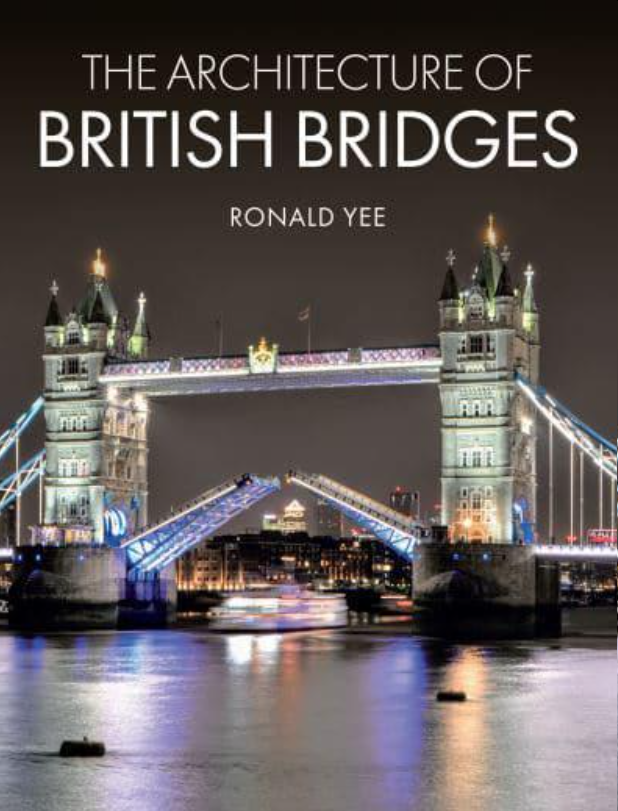The Architecture of British Bridges
The Architecture of British Bridges, Ronald Yee, 2021, 224 pages, 280 colour and black-and-white illustrations, hardback.
Bridges are rarely thought of as architecture, yet they well represent the three famous principles of good design formulated by the Roman architect and engineer Vitruvius in his book ‘De Architectura for firmitas, utilitas and venustas’ (firmness, commodity and delight). Bridges are also one of the few building types where form and structure are given equal weight. This demands creative teamwork and the negation of professional boundaries that can be a problem in the design of buildings.
The author of ‘The Architecture of British Bridges’, Ronald Yee, is an internationally renowned bridge architect, whose work includes the Pont Vasco de Gama in Lisbon and the Rose Fitzgerald Kennedy Bridge in Ireland. He comes from a dynasty of bridge designers. Yee begins with an explanation in non-technical language of the principles of bridge design and the various structural methods used to support them. A central argument is how construction and aesthetics have been combined to achieve good design, and that, bearing in mind that alternative solutions may be technically feasible for most bridging projects, appearance should always be a deciding factor.
The major part of the book is a gazetteer of significant bridges. This is subdivided into chapters based on basic construction types, each of which is explained in an opening section. The first chapter deals with stone bridges, from the primitive Tarr Steps clapper bridge on Exmoor, through the medieval period to the later arched masonry bridges such as Thomas Harrison’s elegant Grosvenor Bridge in Chester of 1832, which remained the longest single-span arch in the world for 30 years. Timber bridges have an even longer timescale, from Roman military bridges up to the present day. Brick bridges began in the 15th century, reaching their climax in the railway age with the construction of mighty viaducts.
By this time iron had become an alternative material, before it was developed as the pre-eminent bridge construction choice. Iron, in turn was replaced by steel, which is capable of being used in several different forms: box girders, steel-arched structures, suspension and cable-stayed bridges, all of which remain viable options. At the same time reinforced concrete has offered an alternative freedom of expression, although its aesthetic potential has not always been as successfully achieved.
The book ends with shorter chapters on movable bridges, bridge parapet design and bridge lighting, the last of which offers opportunities for heritage presentation as seen in the London Illuminated River project. On the way the reader will learn about the effect of high winds on suspension bridges, sometimes with tragic results; the ingenuity of movable bridge designers; and the predisposition of lateral movement due to ‘synchronous lateral excitation’ caused by pedestrians walking in step, which affected the Millennium Footbridge across the Thames until it was alleviated by the insertion of dampers below the deck.
The well-priced book, which is illustrated with a multitude of good photographs, will make you look at bridges with greater attention and understanding. These are historic structures that are often undervalued and under-protected.
This article originally appeared as ‘Firmness, commodity, delight’ in the Institute of Historic Building Conservation’s (IHBC’s) Context 171, published in March 2022. It was written by Peter de Figueiredo, reviews editor of Context.
--Institute of Historic Building Conservation
Related articles on Designing Buildings
- Bascule bridge.
- Bridge chapel.
- Bridges.
- Clifton Suspension Bridge.
- Conservation.
- Five bridges worth visiting during a UK staycation.
- Going the extra mile to extend the lifespan of the Menai Suspension Bridge.
- Heritage.
- IHBC articles.
- Institute of Historic Building Conservation.
- John Rennie.
- Movable bridge.
- Parleys Canyon Wildlife Bridge.
- Pontoon bridge.
- Retractable bridge.
- Submersible bridge.
- Swing bridge.
IHBC NewsBlog
Images from inside a Grade II listed hotel show the scale of its collapse
The Corbett Arms in Tywyn has fallen into serious disrepair.
Old Sarum fire in listed (& disputed) WW1 Hangar - Wiltshire Council has sought legal advice after fire engulfed a listed First World War hangar that was embroiled in a lengthy planning dispute.
UK Antarctic Heritage Trust launches ‘Virtual Visit’ website area
The Trust calls on people to 'Immerse yourself in our heritage – Making Antarctica Accessible'
Southend Council pledge to force Kursaal owners to maintain building
The Council has pledged to use ‘every tool in the toolbox’ if urgent repairs are not carried out.
HE’s Research Magazine publishes a major study of the heritage of England’s suburbs
The article traces the long evolution of an internal programme to research 200 years of suburban growth
IHBC Context 183 Wellbeing and Heritage published
The issue explores issues at the intersection of heritage and wellbeing.
SAVE celebrates 50 years of campaigning 1975-2025
SAVE Britain’s Heritage has announced events across the country to celebrate bringing new life to remarkable buildings.
IHBC Annual School 2025 - Shrewsbury 12-14 June
Themed Heritage in Context – Value: Plan: Change, join in-person or online.
200th Anniversary Celebration of the Modern Railway Planned
The Stockton & Darlington Railway opened on September 27, 1825.
Competence Framework Launched for Sustainability in the Built Environment
The Construction Industry Council (CIC) and the Edge have jointly published the framework.















